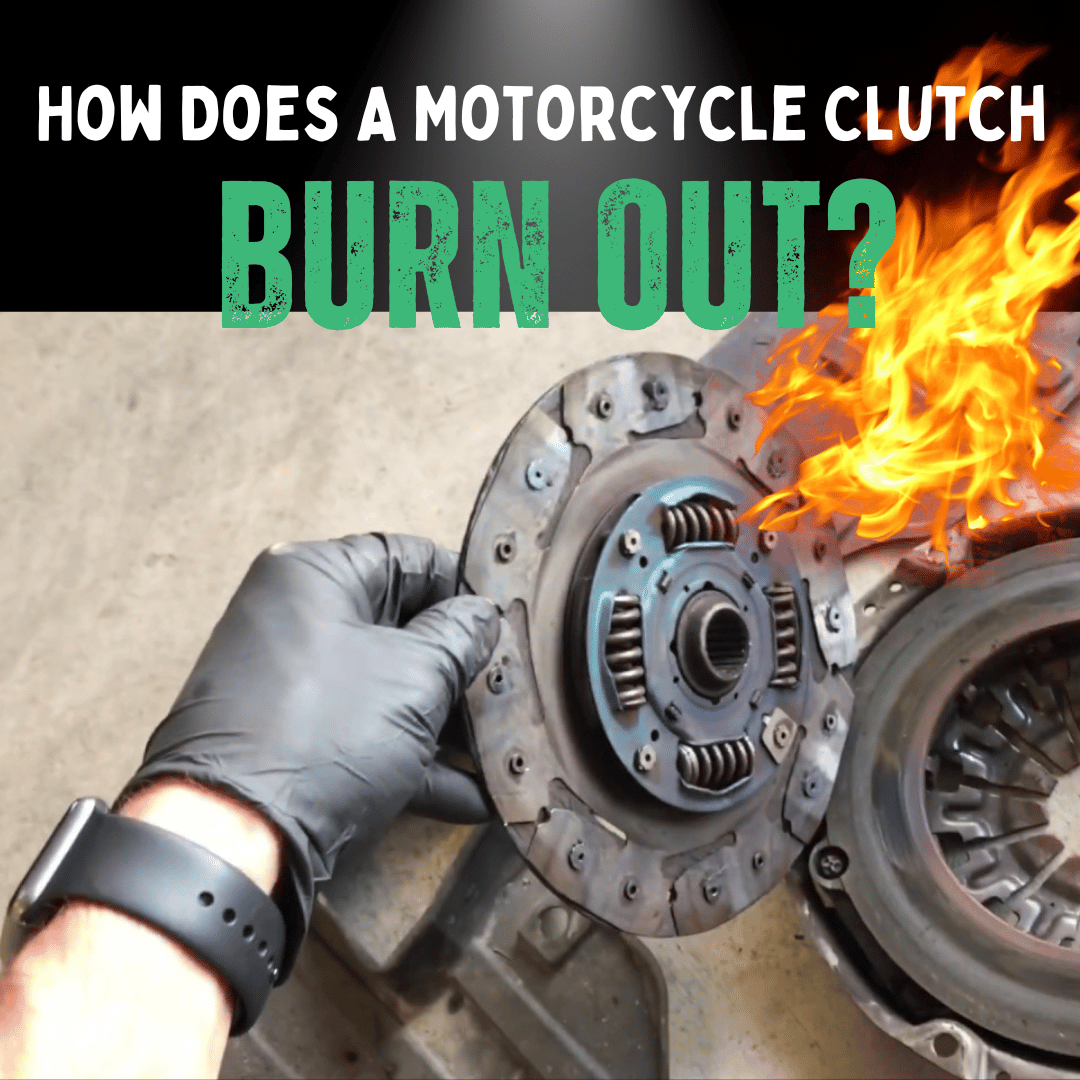
Published: 14 September 2023
Updated: 24 March 2025
You’re ready to ride your motorcycle, but something’s off—your clutch isn’t working right.
Ever wondered what causes a motorcycle clutch to burn out?
Let’s explore the reasons, symptoms, and prevention tips to keep your clutch in top shape.
How Does a Motorcycle Clutch Burn Out?
A motorcycle clutch burns out due to excessive friction from improper gear shifting and mismatched engine-transmission speeds, causing wear on the clutch plates. Techniques like clutchless upshifts can reduce strain and extend clutch life.
Causes of Motorcycle Clutch Burnout
Friction and Heat
Friction helps your clutch engage and disengage, but too much—combined with heat—can lead to burnout.
Top 5 Reasons for Clutch Burnout

1. Slipping the Clutch
Slipping the clutch too much in traffic or on hills creates excessive heat, wearing out the clutch plates.
2. Aggressive Riding
Rough off-road riding or aggressive clutch use overheats the clutch, especially wet clutches, leading to damage.
3. Incorrect Cable Adjustment
Improper cable adjustment causes premature wear, like wearing ill-fitting shoes—it’s uncomfortable for your clutch.
4. Hard Starts and Wheelies
Hard starts and wheelies stress the clutch, causing it to wear out faster than normal.
5. Cable Stretching or Loose Screws
Stretched cables or loose screws disrupt clutch operation, accelerating plate wear.
| Cause | Description |
|---|---|
| Slipping the Clutch | High friction and heat from slipping wears out clutch plates. |
| Aggressive Riding | Overheating from rough off-road or aggressive use damages the clutch. |
| Incorrect Cable Adjustment | Lack of free play causes premature clutch wear. |
| Hard Starts and Wheelies | Extra stress from hard starts or wheelies leads to early wear. |
| Cable Stretching or Loose Screws | Stretching or loosening accelerates clutch plate burnout. |
Related: 25 Game-Changing Motorcycle Hacks
Types of Motorcycle Clutches
Wet vs. Dry Clutches
Wet Clutches
Wet clutches are oil-lubricated, keeping them cool but prone to overheating with aggressive use.
Dry Clutches
Dry clutches lack oil, leading to faster wear from friction but no risk of oil-related issues.
Signs of a Burned-Out Clutch

Grinding Noises
Grinding or rattling when engaging the clutch indicates wear on the clutch components.
Burning Smell
A burning odor signals clutch overheating, often due to slipping.
Shifting Issues
Difficulty shifting gears may point to clutch drag, where the clutch doesn’t fully disengage.
Spongy Clutch Lever
A soft or spongy lever suggests clutch wear or air in the hydraulic system.
High RPM, Low Power
If RPMs rise without speed increase, clutch slippage is likely the issue.
Related: How to Shift Gears on a Motorcycle
Preventing Clutch Burnout
Key Prevention Tips
- Avoid Slipping: Don’t hold the clutch partially engaged for long periods.
- Limit Aggressive Use: Reduce rough off-road riding or hard clutch use.
- Adjust Cables Properly: Ensure correct cable tension during maintenance.
- Skip Hard Starts: Avoid hard starts and wheelies to reduce stress.
- Check Cables and Screws: Inspect monthly for stretching or looseness.
Clutch Maintenance Checklist
- Monthly Cable Checks: Look for stretching or wear.
- Quarterly Plate Inspection: Check clutch plates for damage.
- Half-Yearly Fluid Changes: Replace fluid in wet clutches twice a year.
- Yearly Professional Check: Have a mechanic inspect the clutch system.
Clutch Lifespan

Average clutch lifespan is around 60,000 miles, but aggressive riding or poor maintenance can reduce it to 30,000 miles.
With proper care, some clutches last over 100,000 miles.
Repairing a Burned-Out Clutch
Repairing a clutch is complex—consider a professional unless you’re experienced. Here’s a basic guide:
- Identify Symptoms: Confirm signs like grinding, burning smells, or shifting issues.
- Gather Tools: You’ll need a jack, support columns, and replacement parts (clutch disc, pressure plate, etc.).
- Prepare the Bike: Park on a flat surface, turn off the engine, and engage the handbrake.
- Elevate the Bike: Use a jack to lift the bike for access.
- Disassemble: Remove the transmission and clutch assembly.
- Inspect Damage: Check clutch plates for wear or overheating.
- Replace Parts: Swap out damaged components with quality replacements.
- Reassemble: Put everything back together, ensuring proper fit.
- Test: Lower the bike and test for smooth acceleration and gear shifts.
Choosing a Quality Clutch

Opt for a high-quality clutch from well-reviewed brands—consult your mechanic or other riders.
Investing in quality ensures durability and fewer repairs.
Conclusion
Prevent clutch burnout with proper riding habits, regular maintenance, and timely repairs.
Keep your clutch in check, and enjoy a smoother, safer ride!
FAQ’s
What causes a motorcycle clutch to burn out?
Excessive friction from slipping, aggressive riding, incorrect cable adjustment, hard starts, or loose screws can cause burnout.
Can city riding wear out my clutch faster?
Yes, frequent stop-and-go traffic increases clutch use, accelerating wear.
How do I know if my clutch plates need replacing?
Look for grinding noises, a burning smell, shifting issues, or a spongy clutch lever—consult a mechanic for confirmation.
Can better riding techniques prevent clutch burnout?
Absolutely—smooth gear shifts, avoiding high-speed clutch use, and proper lever adjustment can extend clutch life.
How long does a motorcycle clutch typically last?
Most clutches last around 60,000 miles, but aggressive riding can reduce this to 30,000 miles, while good care can extend it beyond 100,000 miles.
Ready to Ride? 🚀
Loved our 2025 guide on motorcycle clutch burnout?
Explore more at RiiRoo.com or chat live with us!






Share:
The Definitive Guide to The Different Types of Motorbike Clutches
10 Ways To Avoid Your Motorcycle Clutch From Burning Out